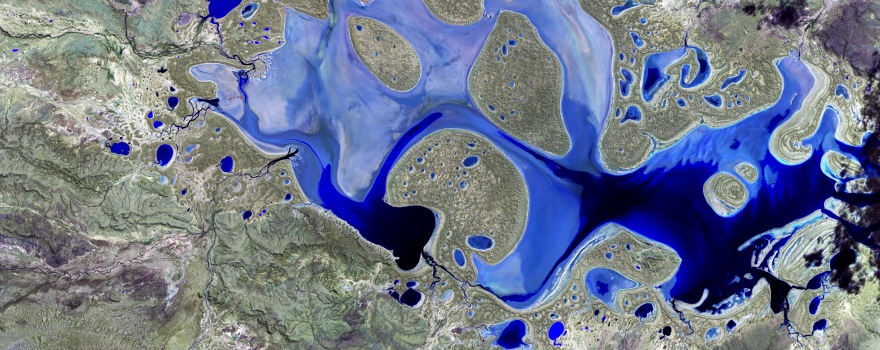
In science news this week: The U.S. Fish and Wildlife Service and partners are working to improve habitat at the Carpinteria Salt Marsh Reserve; Flying High: Drone Use in Fisheries Research; As temperatures rise, more California forests will burn; A New Way to Measure How Water Moves; New viruses discovered in endangered wild Pacific salmon populations; Seaweed farming as a versatile tool in effort to mitigate climate change; Uncovering ocean iron-level mystery; and more …
The U.S. Fish and Wildlife Service and partners are working to improve habitat at the Carpinteria Salt Marsh Reserve: ““It’s a very secretive salt marsh bird,” said U.S. Fish and Wildlife Service Coastal Program biologist Colleen Grant. “You could be 20 feet away from them, but you’ll never see them.” The light-footed Ridgway’s rail (formerly known as light-footed clapper rail) once inhabited the wetlands that occupied California’s coast, from Santa Barbara County to San Quintin Bay in Baja California, Mexico. Today, the species ranges from southern Ventura County to Ensenada. The last sighting of the rail in Santa Barbara County’s Carpinteria Salt Marsh Reserve was in 2004. … ” Read more from the US FWS here: The U.S. Fish and Wildlife Service and partners are working to improve habitat at the Carpinteria Salt Marsh Reserve
Flying High: Drone Use in Fisheries Research: “Drones have been a promising prospect for conservation research since they buzzed onto the scene in the early 2000s. Rapidly developing technology has resulted in cheaper, tougher, and more versatile drones that have opened up a world of possibilities for the aeronautically inclined biologist. Although the field of fisheries has somewhat lagged behind other research disciplines in its adoption of drones, recent innovative applications are providing fish scientists with valuable information from a new perspective. A recent publication details some of these advances and provides a guide to drone use in fish research, which offers some potentially incredible benefits (Harris et al 2019). … ” Read more from FishBio here: Flying High: Drone Use in Fisheries Research
As temperatures rise, more California forests will burn: “On August 5, a Washington Post headline announced, “This year’s fire season in California could be ‘very active.'” In spite of the wet winter, the Golden State was expected to face “an above-normal chance for large wildfires as [it] heads into late summer and fall.” After a slow start, a heat wave at the end of July seemed to “flip a switch.” Over 4,000 fires have broken out since. Post reporter Diana Leonard sought out 2016 Center for Climate and Life Fellow and Lamont-Doherty Earth Observatory associate research professor Park Williams to explain why California is expected to burn in 2019—albeit not as much as last year—despite wetter weather. “A heat wave today,” Williams told the Post, “is going to have a much more potent influence on flammability than one 150 years ago when temperatures were 3.5 degrees cooler.” … ” Read more from PhysOrg here: As temperatures rise, more California forests will burn
A New Way to Measure How Water Moves: “When a chemical spills in the environment, it’s important to know how quickly the spill will spread. If a farmer irrigates a crop, the person will need to know how fast the water should move through the soil and be absorbed by the roots. In both cases, a good understanding of water pore structure is necessary. A new method to measure pore structure and water flow is described in a study published in the journal Water Resources Research. With it, scientists should be able to more accurately determine how fast water, contaminants, nutrients and other liquids move through the soil—and where they go. ... ” Read more from UC Davis here: A New Way to Measure How Water Moves
New viruses discovered in endangered wild Pacific salmon populations: “Three new viruses—including one from a group of viruses never before shown to infect fish—have been discovered in endangered Chinook and sockeye salmon populations. While the impact of the viruses on salmon health isn’t yet known, all three are related to viruses that cause serious disease in other species. “We were surprised to find viruses which had never before been shown to infect fish,” said Gideon Mordecai, researcher at UBC’s department of earth, ocean and atmospheric sciences. … ” Read more from PhysOrg here: New viruses discovered in endangered wild Pacific salmon populations
Seaweed farming as a versatile tool in effort to mitigate climate change: “According to the Intergovernmental Panel on Climate Change (IPCC), addressing carbon emissions from our food sector is absolutely essential to combating climate change. While land and agriculture took center stage in the panel’s most recent report, missing was how the oceans at large could help in that fight. Seaweed, perceived by some as little more than marine debris on the beach, could be a new player in the effort to mitigate climate change. So say researchers at UC Santa Barbara, who investigated the carbon offsetting potential of seaweed aquaculture. … ” Read more from Science Daily here: Seaweed farming as a versatile tool in effort to mitigate climate change
Climate change has altered winter precipitation across the Northern Hemisphere: “A team of scientists has successfully teased out the influence of human-caused climate change on wintertime precipitation over the last century, showing that the warming climate altered wintertime rainfall and snowfall across the Northern Hemisphere. The study, led by scientists at the National Center for Atmospheric Research (NCAR), used an innovative approach that relied on observations of precipitation and large-scale atmospheric circulation patterns, along with statistical techniques and computer climate simulations. This enabled the research team to identify the amount of average monthly precipitation in specific regions of North American and Eurasia that fell as a result of human impacts on the climate, rather than natural variability. … ” Read more from NCAR here: Climate change has altered winter precipitation across the Northern Hemisphere
Uncovering ocean iron-level mystery: “The middle of the Earth’s oceans are filled with vast systems of rotating currents known as subtropical gyres. These regions occupy 40% of the Earth’s surface and have long been considered remarkably stable biological deserts, with little variation in chemical makeup or the nutrients needed to sustain life. However, there exists a strange anomaly in the North Pacific Subtropical Gyre ecosystem that has puzzled scientists for years. In this region that occupies the Pacific Ocean between China and the United States, the chemistry changes periodically. There’s a particularly notable fluctuation in the levels of phosphorus and iron, which affects the overall nutrient composition and ultimately impacts biological productivity. … ” Read more from Science Daily here: Uncovering ocean iron-level mystery
Maven’s XKCD Comic Pick of the Week …
 Sign up for daily email service and you’ll never miss a post!
Sign up for daily email service and you’ll never miss a post!
Sign up for daily emails and get all the Notebook’s aggregated and original water news content delivered to your email box by 9AM. Breaking news alerts, too. Sign me up!
About Science News and Reports: This weekly feature, posted every Thursday, is a collection of the latest scientific research and reports with a focus on relevant issues to the Delta and to California water, although other issues such as climate change are sometimes included. Do you have an item to be included here? Submissions of relevant research and other materials is welcome. Email Maven


